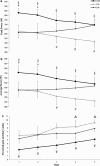Administration of Caffeine in Alternate Forms
- PMID: 29368182
- PMCID: PMC5790855
- DOI: 10.1007/s40279-017-0848-2
Administration of Caffeine in Alternate Forms
Abstract
There has been recent interest in the ergogenic effects of caffeine delivered in low doses (~ 200 mg or ~ 3 mg/kg body mass) and administered in forms other than capsules, coffee and sports drinks, including chewing gum, bars, gels, mouth rinses, energy drinks and aerosols. Caffeinated chewing gum is absorbed quicker through the buccal mucosa compared with capsule delivery and absorption in the gut, although total caffeine absorption over time is not different. Rapid absorption may be important in many sporting situations. Caffeinated chewing gum improved endurance cycling performance, and there is limited evidence that repeated sprint cycling and power production may also be improved. Mouth rinsing with caffeine may stimulate nerves with direct links to the brain, in addition to caffeine absorption in the mouth. However, caffeine mouth rinsing has not been shown to have significant effects on cognitive performance. Delivering caffeine with mouth rinsing improved short-duration, high-intensity, repeated sprinting in normal and depleted glycogen states, while the majority of the literature indicates no ergogenic effect on aerobic exercise performance, and resistance exercise has not been adequately studied. Studies with caffeinated energy drinks have generally not examined the individual effects of caffeine on performance, making conclusions about this form of caffeine delivery impossible. Caffeinated aerosol mouth and nasal sprays may stimulate nerves with direct brain connections and enter the blood via mucosal and pulmonary absorption, although little support exists for caffeine delivered in this manner. Overall, more research is needed examining alternate forms of caffeine delivery including direct measures of brain activation and entry of caffeine into the blood, as well as more studies examining trained athletes and female subjects.
Figures




References
-
- Spriet LL. Caffeine. In: Maughan RJ, editor. The encyclopaedia of sports medicine: an IOC medical commission publication. Sports Nutrition. 19. Oxford: Wiley; 2013. pp. 313–323.
Publication types
MeSH terms
Substances
LinkOut - more resources
Full Text Sources
Other Literature Sources
Medical

